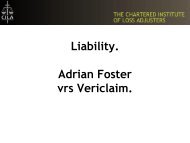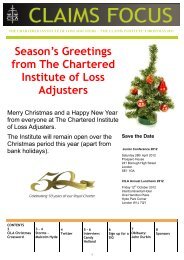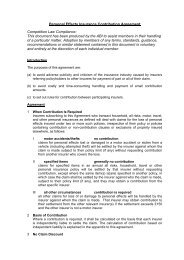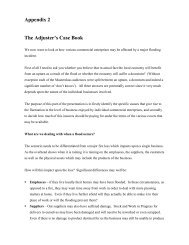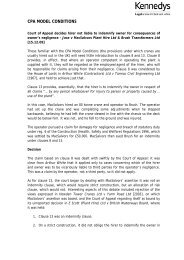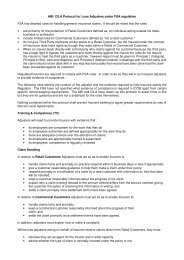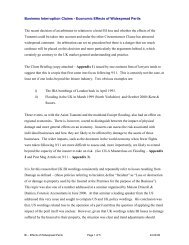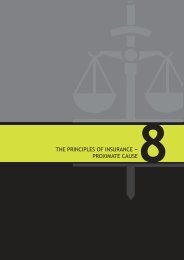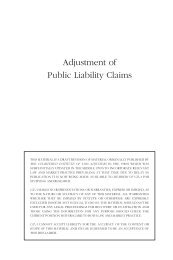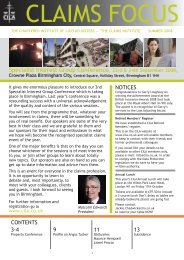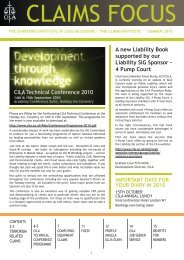Download Speaker's Notes - CILA/The Chartered Institute of Loss ...
Download Speaker's Notes - CILA/The Chartered Institute of Loss ...
Download Speaker's Notes - CILA/The Chartered Institute of Loss ...
Create successful ePaper yourself
Turn your PDF publications into a flip-book with our unique Google optimized e-Paper software.
<strong>CILA</strong> Liability SIG Legal Review Seminar 2013<br />
Speaker <strong>Notes</strong> – Prepared by Martyn Gabbitass,<br />
Chairman <strong>of</strong> the <strong>CILA</strong> Liability SIG<br />
Good afternoon Ladies and Gentlemen.<br />
I am going to take you through a review <strong>of</strong> recent cases in the liability arena which I<br />
believe to be <strong>of</strong> interest also relevance to situations we frequently encounter to include<br />
also one or two quirky cases for those scratching head moments and overall whilst not<br />
exhaustive keeping you abreast <strong>of</strong> the latest legal developments.<br />
I am going to begin with a nuisance case involving complaints by residents against a local<br />
commercial operation, the case <strong>of</strong> Anslow and Others v. Norton Aluminium Limited<br />
(EWHC 2012). <strong>The</strong> Claimants were 132 residents who lived in or around Norton Canes,<br />
near Birmingham. <strong>The</strong> Defendant operated an aluminium foundry which had been in<br />
operation since 1952 prior to which the site had operated as a coal mine. <strong>The</strong> Defendant<br />
had the required environmental permit and since 1998 it also operated the foundry as a<br />
sand casting business. <strong>The</strong> Claimants alleged that the operation <strong>of</strong> the foundry created<br />
excessive dust, noise and odour over an extended period <strong>of</strong> time and in particular over the<br />
period <strong>of</strong> their claim from 2002 to 2010. In 2002 the local parish council had written to<br />
the Environmental Health Department describing many complaints <strong>of</strong> odours by residents.<br />
In March 2004 the Environmental Agency issued a prohibition notice to shut down the<br />
factory amongst others due to a failure to carry out an odour survey <strong>of</strong> the foundry. This<br />
prohibition notice was however lifted the next day. Later in 2008 Cannock Chase District<br />
Council wrote to the Defendant about significant justified odour complaints. <strong>The</strong> High<br />
1 | P a g e S p e a k e r N o t e s<br />
C I L A L I A B I L I T Y S I G S E M I N A R 2 0 1 3
Court held that there had been unreasonable interference with the Claimants’ enjoyment<br />
<strong>of</strong> property because <strong>of</strong> odour between 2003 and 2010. Judge McKenna made reference to<br />
the Court <strong>of</strong> Appeal decision in Barr and Others v. Biffa Waste Services Limited noting that<br />
this earlier decision had highlighted that for Claimants to establish a nuisance, there is no<br />
requirement for the Court to set a precise ‘threshold’ in terms <strong>of</strong> a number <strong>of</strong> days per<br />
year on which complaints <strong>of</strong> odour had been made. In short, complaints by residents are<br />
not a pre-requisite to nuisance; substantial interference in comfortable and convenient<br />
enjoyment <strong>of</strong> land is required. Before moving on, I would comment that damages for<br />
those in the most affected area were allowed at a figure <strong>of</strong> £2,000 annually and those in<br />
the least affected areas the annual figure was set at £750. I believe that these sums can<br />
be introduced into other areas where we are met with loss <strong>of</strong> amenity claims; the Courts<br />
have long refused to make substantial awards against these types <strong>of</strong> claim.<br />
Sticking with quantum for the moment and a claim for loss <strong>of</strong> dependency under Section<br />
1(3)(b) <strong>of</strong> the Fatal Accidents Act 1976 in the case <strong>of</strong> Swift –v- Secretary <strong>of</strong> State for<br />
Justice (CA 2013). This case was brought on a potential point <strong>of</strong> principle in that the<br />
couple concerned had co-habited for less than two years. <strong>The</strong> deceased’s partner, the<br />
deceased being killed in an accident at work, gave birth to their child after his death.<br />
Liability was not an issue. Whilst the infant’s claim was successful; the partner’s claim<br />
failed. Quite simply, the couple had not been co-habiting for two years. <strong>The</strong> matter<br />
reached the Court <strong>of</strong> Appeal because <strong>of</strong> that ever increasing chestnut the European<br />
Convention on Human Rights. <strong>The</strong> partner argued that the Fatal Accidents Act 1976 was<br />
incompatible with the European Convention on Human Rights and that the Act had<br />
discriminated against couples who had not co-habited for very long. <strong>The</strong> appeal was<br />
dismissed with the Court <strong>of</strong> Appeal commenting that the relevant section did not<br />
2 | P a g e S p e a k e r N o t e s<br />
C I L A L I A B I L I T Y S I G S E M I N A R 2 0 1 3
discriminate but limited the right to those couples whose relationship had demonstrated<br />
some degree <strong>of</strong> permanency.<br />
Moving on to another area <strong>of</strong> law, vicarious liability but within the employer’s liability<br />
sphere and involving a claim brought by a sole director and shareholder <strong>of</strong> the defendant<br />
company. This is not an infrequent matter falling for a liability adjusters’ attention. <strong>The</strong><br />
case is Brumder v. Motornet Services and Repairs Limited & Anor.(CA 2013).<br />
<strong>The</strong> Claimant was the sole director and shareholder <strong>of</strong> the Defendant company. He<br />
sustained a serious injury to his finger when he climbed down from a hydraulic ramp<br />
following the failure <strong>of</strong> the ramp mechanism. <strong>The</strong> Claimant brought a claim for damages<br />
against both his company and its insurer. <strong>The</strong> Claimant was found to be 100% responsible<br />
for the accident and amongst others, the Court at first instance holding him responsible<br />
for health and safety and for maintaining equipment. On appeal, it was held that as sole<br />
director and shareholder the Claimant was responsible for the obligations <strong>of</strong> the company<br />
under the Health & Safety Regulations and therefore could not sue his company as he had<br />
failed to meet those obligations.<br />
Had another employee been responsible for the accident and/or responsible for health and<br />
safety issues in the company, then I suspect the decision would have been decided<br />
differently and then turn on the degree to which the Claimant had contributed to his<br />
injury.<br />
Staying with employer’s liability, but highlighting the continuing saga <strong>of</strong> Mesothelioma<br />
claims and the case <strong>of</strong> International Energy Group Limited v. Zurich Insurance plc (CA<br />
2013). Here the question posed concerned policy wordings and policy response to a<br />
Mesothelioma claim following the Claimant’s exposure to asbestos. <strong>The</strong> brief<br />
3 | P a g e S p e a k e r N o t e s<br />
C I L A L I A B I L I T Y S I G S E M I N A R 2 0 1 3
circumstances are that the deceased employee had made a claim against International<br />
Energy Group Limited in the Guernsey Court before he died. <strong>The</strong> employer had settled<br />
the claim and the litigation surrounded the employer’s claim for an indemnity from its<br />
insurer, Zurich. Zurich had insured the Claimant’s predecessor for six <strong>of</strong> the relevant<br />
27 years. <strong>The</strong> policy wording was identical each time the policy was renewed. Zurich<br />
sought to argue that it was only liable for the period during which it provided the cover.<br />
At Trial, it was held that Zurich had to indemnify their Insured for the cost <strong>of</strong> the<br />
employee’s claim, but only for the six years <strong>of</strong> cover. Both insurer and employer<br />
appealed. <strong>The</strong> Court <strong>of</strong> Appeal held that Zurich’s liability to its insured depended on the<br />
wording <strong>of</strong> the policy as identified in the ‘trigger’ litigation case. Accordingly, Zurich was<br />
liable to indemnify International Energy Group Limited for the whole <strong>of</strong> the claim not just<br />
the proportion when they were insurer.<br />
I understand that Zurich are known to be considering an appeal and in the absence <strong>of</strong> a<br />
successful appeal then insurers will have to accept that they will no longer receive<br />
contribution from solvent insureds for Mesothelioma claims. This is an important decision<br />
involving a review <strong>of</strong> the law <strong>of</strong> causation in Mesothelioma that resulted from the “special<br />
rule” created in the Fairchild case. <strong>The</strong> special rule established causation by a material<br />
contribution to the risk <strong>of</strong> disease rather than pro<strong>of</strong> <strong>of</strong> actual contribution to the disease.<br />
Reference was made in the International Energy Group case to the Barker decision where<br />
the House <strong>of</strong> Lords decided that the special rule should be interpreted so that each<br />
wrongdoer would only be liable for their share <strong>of</strong> the risk <strong>of</strong> the disease. Ins<strong>of</strong>ar as UK<br />
cases are concerned, then the Compensation Act 2006 overturned the Barker decision.<br />
However, in the International Energy Group case the Compensation Act does not apply<br />
since it originated in Guernsey. I have no doubt that we have not heard the last <strong>of</strong><br />
4 | P a g e S p e a k e r N o t e s<br />
C I L A L I A B I L I T Y S I G S E M I N A R 2 0 1 3
Mesothelioma cases and indeed the Court <strong>of</strong> Appeal in International Energy Group did<br />
suggest that the Barker judgement was “problematical”.<br />
Moving on to public liability matters. In Alexander v. Freshwater Properties Limited and<br />
Christopher Place t/a Place Construction (CA 2012), this was a case involving the<br />
landlord <strong>of</strong> a block <strong>of</strong> flats and a contractor who was carrying out refurbishment works. At<br />
first instance the recorder had found both parties liable when a resident was injured as<br />
she attempted to close the front door <strong>of</strong> the block <strong>of</strong> flats. However, the Court <strong>of</strong> Appeal<br />
held that the recorder had erred by holding that the builder had a 75% responsibility for<br />
the accident; the Court <strong>of</strong> Appeal held that the landlord was equally responsible for the<br />
danger that had been created in relation to the door. <strong>The</strong> landlord was responsible for<br />
the upkeep <strong>of</strong> the common parts including the front door and the contractors had been<br />
engaged by the landlord to carry out a programme <strong>of</strong> refurbishment to the building that<br />
included the removal, polishing and replacement <strong>of</strong> the exterior handles on the front<br />
door. <strong>The</strong> Claimant alleged that the self-closing mechanism was defective and that it had<br />
been necessary for anyone leaving the building to pull the door shut in order to ensure<br />
that the lock engaged properly. <strong>The</strong> contactor had removed the exterior handle and<br />
therefore users had to pull the door by grasping its edge taking care to remove fingers out<br />
<strong>of</strong> the way before it closed onto them. <strong>The</strong>re was also a notice displayed advising users to<br />
always pull the outer door fully closed and make sure that the catch clicked shut. <strong>The</strong><br />
presence <strong>of</strong> the sign was evidence that the self-closing mechanism was not effective. <strong>The</strong><br />
Court <strong>of</strong> Appeal commented that this was an accident waiting to happen.<br />
Sticking with occupiers liability; in Drysdale v. Hedges (QBD 2012) it was held that a<br />
landlord owed no duty <strong>of</strong> care under Section 4 <strong>of</strong> the Defective Premises Act 1972 or<br />
Section 2 <strong>of</strong> the Occupiers Liability Act 1957 to her tenant who had slipped on painted<br />
5 | P a g e S p e a k e r N o t e s<br />
C I L A L I A B I L I T Y S I G S E M I N A R 2 0 1 3
steps on her property and sustained injury. <strong>The</strong> Court recognised that the Claimant was<br />
owed a common law duty <strong>of</strong> care but that duty had not been breached as although the<br />
presence <strong>of</strong> paint on the steps significantly increased their slipperiness, it had not been<br />
unreasonable for the landlord to paint them using outdoor paint. This case is a useful aide<br />
memoire in that the Court commented on the inter-play between the Defective Premises<br />
and Occupiers Liability Acts. Section 2 <strong>of</strong> the 1957 Act applies generally whereas Section 4<br />
<strong>of</strong> the Defective Premises Act defines a landlord’s duty. Specific comment was made that<br />
it cannot have been Parliament’s intention for both Section 2 and Section 4 to define a<br />
landlord’s duty. Section 4 <strong>of</strong> the 1957 Act was replaced by the 1972 Act and therefore<br />
Section 4 <strong>of</strong> the 1972 Act defined the extent <strong>of</strong> a landlord’s duty.<br />
<strong>The</strong> paint was additional to the stone and it did not replace it. <strong>The</strong> stone did not require<br />
repair neither did the paint. What was required was the removal <strong>of</strong> the paint. However,<br />
on the facts the presence <strong>of</strong> the paint on the steps did not cause the steps not to be in<br />
good repair. <strong>The</strong>refore, there was no breach <strong>of</strong> Section 4 <strong>of</strong> the 1972 Act nor the tenancy<br />
agreement. One <strong>of</strong> the issues here was that there was an unguarded drop to basement<br />
level and because the Claimant had fallen some distance to the basement level, serious<br />
injury had been sustained. However, where as here the Act did not apply, a landlord’s<br />
duty was to take reasonable care not to create a risk <strong>of</strong> unnecessary injury. Whilst the<br />
Court recognised that the presence <strong>of</strong> rain increased the likelihood <strong>of</strong> slipping on the steps<br />
and the presence <strong>of</strong> paint on the steps significantly increased the risk <strong>of</strong> slipping that in<br />
itself did not establish liability. Importantly, the paint was suitable for use outside and<br />
contained no warning against its use on steps or <strong>of</strong> it becoming slippery when wet. <strong>The</strong>re<br />
were references to semi-gloss and producing a sheen that may have alerted the<br />
‘knowledgeable’ to the fact that the paint was not suitable for use on steps, but not the<br />
6 | P a g e S p e a k e r N o t e s<br />
C I L A L I A B I L I T Y S I G S E M I N A R 2 0 1 3
man on the street. It was not unreasonable to have applied the paint to the steps in light<br />
<strong>of</strong> the expert evidence and there was no breach <strong>of</strong> duty.<br />
At last year’s seminars we included a subsidence presentation and there has been an<br />
important decision from the Court <strong>of</strong> Appeal with regard to the liability <strong>of</strong> local authorities<br />
to third parties for damage caused by tree roots. I refer to the case <strong>of</strong> Berent v. Family<br />
Mosaic Housing and Islington Borough Council (CA 2012). <strong>The</strong> Claimant sought damages<br />
following subsidence to her house as a result <strong>of</strong> tree roots growing under her property.<br />
She also pursued a claim for damages for distress, inconvenience and loss <strong>of</strong> amenity on<br />
the grounds that the trees should have been removed earlier than they were. Physical<br />
damage had occurred in 2003/2004 and the trees were finally removed in March 2011.<br />
Both defendants, Housing Association and Local Authority, denied liability. At Trial,<br />
damage at the right and rear <strong>of</strong> the house was not related to tree roots, but more to<br />
defective drains and vibration caused by railway tunnelling work. However, it wasn’t clear<br />
whether trees had made a material contribution to the damage at the front and left <strong>of</strong> the<br />
house. Nonetheless, it was held that in the period before the damage was caused there<br />
was no basis upon which either the Housing Association or the Local Authority should have<br />
appreciated that there was a real risk that the trees would cause damage to the<br />
Claimant’s property either alone or in conjunction with other factors and that as such<br />
there had been no breach <strong>of</strong> duty. However, the Court awarded £5,000 in respect <strong>of</strong> the<br />
claim for distress, inconvenience and loss <strong>of</strong> amenity on the basis that the trees ought to<br />
have been removed in the Autumn <strong>of</strong> 2010. You will recall that damage occurred in<br />
2003/2004 and over roughly a six year period the loss <strong>of</strong> amenity aspect, which I<br />
highlighted in the first case involving Norton Aluminium, is less than £1,000 per annum.<br />
Both Claimant and Defendants appealed against the initial decision. <strong>The</strong> Court <strong>of</strong> Appeal<br />
7 | P a g e S p e a k e r N o t e s<br />
C I L A L I A B I L I T Y S I G S E M I N A R 2 0 1 3
eiterated the accepted proposition <strong>of</strong> what it was reasonable to do in the light <strong>of</strong> the<br />
foreseeable risk. <strong>The</strong> Claimant’s expert did not support her pleaded case ins<strong>of</strong>ar as the<br />
alleged failure properly to manage the trees by pruning prior to 2003/2004. His written<br />
evidence stated that pruning promoted growth and if not severe and very frequent could<br />
lead to increased water extraction and lent no support to the notion that there was in the<br />
instant case a breach <strong>of</strong> duty in failing properly to control growth prior to 2003/2004.<br />
<strong>The</strong>re was much debate on the damage to the property and whether the Defendants<br />
should have responded to the occurrence <strong>of</strong> damage by removing the trees earlier than<br />
they did. <strong>The</strong> Court <strong>of</strong> Appeal held that the evidence came nowhere close to establishing<br />
the liability <strong>of</strong> the local authority or the housing association whether on a basis that they<br />
should have long before removed the trees or on the basis that in the earlier years they<br />
should have carried out more pruning or other risk prevention measures.<br />
Of greater importance I believe is that the cross appeal by the Defendants on the damages<br />
awarded bore fruit. <strong>The</strong> Court <strong>of</strong> Appeal recognised that damages were intended to<br />
provide modest not generous compensation and accordingly an award <strong>of</strong> £150 was<br />
substituted. This is further clear evidence <strong>of</strong> the Courts being reluctant to provide<br />
Claimants with a financial windfall in claims for alleged distress, inconvenience and loss <strong>of</strong><br />
amenity following limited property damage.<br />
Staying with property damage then Harrison & Ors v. Shepherd Homes Limited & Ors (CA<br />
2012) involved diminution in value. <strong>The</strong> Defendants had built houses on an estate. Many<br />
suffered significant cracking as a result <strong>of</strong> defects in their foundations. Liability was<br />
determined in the Defendants’ favour and the correct measure <strong>of</strong> damages was an award<br />
for the diminution in value <strong>of</strong> the houses. Both parties had experts and at Trial it was<br />
held that the capital comparison method used by the Defendant’s valuation expert was<br />
8 | P a g e S p e a k e r N o t e s<br />
C I L A L I A B I L I T Y S I G S E M I N A R 2 0 1 3
the more appropriate for assessing the diminution in value <strong>of</strong> those houses that were<br />
probably mortageable whereas the investment return method used by the Claimants’<br />
valuation expert was considered more appropriate for those houses that were probably not<br />
mortgageable. Those that were mortageable attracted a diminution in value <strong>of</strong> 32.5% and<br />
the Claimants could also recover the cost <strong>of</strong> both current remedial work and carrying out<br />
two lots <strong>of</strong> remedial work over the next 20 years.<br />
<strong>The</strong> Defendants appealed.<br />
Notably, because before judgment was given one <strong>of</strong> the houses on the estate was sold, the<br />
Judge refused to allow the Defendant’s valuation expert to admit further evidence<br />
relating to that sale.<br />
<strong>The</strong> Court <strong>of</strong> Appeal held that the Judge was correct to take account <strong>of</strong> uncertainty by<br />
approaching the question <strong>of</strong> damages <strong>of</strong> diminution in value on a gradated basis and that<br />
they could not interfere with the figure <strong>of</strong> 32.5%. <strong>The</strong>y also held that the approach to the<br />
cost <strong>of</strong> the remedial work was proper and could not be criticised and that there was not<br />
an element <strong>of</strong> double recovery. <strong>The</strong> Court <strong>of</strong> Appeal also dismissed out <strong>of</strong> hand the<br />
Defendant’s request for further evidence commenting that there had to be a limit to the<br />
litigation process and that the Judge had effectively taken the matter into account in any<br />
event.<br />
In summary, repairs and diminution were allowed in this particular case. I am unaware <strong>of</strong><br />
any further appeal having been lodged with the Supreme Court.<br />
Returning to personal injury matters and a not infrequent accident circumstance in recent<br />
years diving into water or as in the case <strong>of</strong> Cockbill v. Riley a paddling pool. This is a sad<br />
9 | P a g e S p e a k e r N o t e s<br />
C I L A L I A B I L I T Y S I G S E M I N A R 2 0 1 3
case in that the teenager concerned suffered a serious hyperflexion injury resulting in a<br />
fracture <strong>of</strong> the spine and incomplete tetraplegia.<br />
He was aged 16 and a friend <strong>of</strong> the Defendant’s daughter who had invited him to a<br />
barbeque party in their garden. One <strong>of</strong> the guests had brought a paddling pool which had<br />
been filled but positioned away from danger, namely the barbeque. Apparently there was<br />
only a small amount <strong>of</strong> alcohol available and several <strong>of</strong> the boys present had jumped into<br />
the paddling pool but always singly and in turn. When the party started to get more<br />
boisterous the Defendant served food to calm things down.<br />
It was shortly after this that the Claimant dived into the pool and was catastrophically<br />
injured. <strong>The</strong> issues before the Court were to what extent had alcohol been available,<br />
what had been going on before the accident, had there been a gap between the earlier<br />
activity and the accident, how the Claimant entered the pool and finally whether the<br />
Claimant had slipped on wet grass. <strong>The</strong> Defendant admitted supplying a modest amount<br />
<strong>of</strong> alcohol and also conceded that he had not controlled the alcohol that guests had<br />
brought, typically a pack <strong>of</strong> lager. <strong>The</strong> evidence was however that none <strong>of</strong> the guests had<br />
drunk alcohol to the point where they were misbehaving, rude, aggressive or unsteady on<br />
their feet. <strong>The</strong> Claimant’s blood alcohol level was between 45 and 60mg/ml enough to<br />
have given a slightly disinhibiting effect but not enough to be visibly affected.<br />
Prior to the Claimant’s accident, six or seven boys had jumped in over the edge <strong>of</strong> the<br />
pool feet first, some landing on their bottoms and one boy had jumped in <strong>of</strong>f a chair but<br />
nobody else had dived or somersaulted into the pool. When the food was served this<br />
caused a break in activity <strong>of</strong> probably less than 15 minutes though during which the<br />
Claimant had entered the pool. It would appear that the Claimant had intended to belly<br />
10 | P a g e S p e a k e r N o t e s<br />
C I L A L I A B I L I T Y S I G S E M I N A R 2 0 1 3
flop but had misjudged the angle so that he struck the bottom <strong>of</strong> the pool with his head.<br />
<strong>The</strong> Claimant was unable to prove on the balance <strong>of</strong> probabilities that he had slipped and<br />
even if he had that would not have been relevant to establish liability. <strong>The</strong> use <strong>of</strong> the<br />
paddling pool would inevitably lead to some spillage but the weather had been hot and dry<br />
for some weeks and the grass would have drained rapidly.<br />
Importantly, it was common ground that the Defendant owed a duty <strong>of</strong> care which<br />
extended to keep an eye on the children’s behaviour and if necessary intervening in a<br />
reasonable manner, though not so as to spoil the party. <strong>The</strong> Court held that it was quite<br />
unrealistic to contend that the use <strong>of</strong> a paddling pool at a party attended by teenage<br />
friends <strong>of</strong> the Defendant’s children created a foreseeable risk <strong>of</strong> significant injury or<br />
justified a formal risk assessment. Equally importantly, the Court held that allowing the<br />
guests to consume modest quantities <strong>of</strong> alcohol did not make the risk <strong>of</strong> significant injury<br />
foreseeable. Further, the Defendant had not been under a legal duty to tell the guests<br />
not to run or jump into the pool and he was therefore not in breach <strong>of</strong> his duty <strong>of</strong> care.<br />
Had the decision on primary liability been decided differently, then the Claimant’s<br />
contributory negligence would have been assessed at 2/3rds.<br />
And finally in deference to the impending seminal changes under the MoJ Portal, I draw<br />
attention to a little known case before Leicester County Court - Patel v. Fortis Insurance<br />
Limited (CC 2011) which involved the Defendant motor insurer failing to acknowledge a<br />
personal injury Claimant’s Claim Notification Form in accordance with the procedure<br />
under the pre-action protocol for low value personal injury claims in road traffic<br />
accidents. Importantly, and with the impending extension <strong>of</strong> the RTA portal into EL and<br />
PL arenas, the Recorder at Leicester County Court held that the Insurers’ failure did not<br />
11 | P a g e S p e a k e r N o t e s<br />
C I L A L I A B I L I T Y S I G S E M I N A R 2 0 1 3
however mean that the claim could not continue under the protocol and the Claimant’s<br />
election to withdraw from the protocol procedure meant that his costs following<br />
settlement <strong>of</strong> his claim would be assessed in accordance with the fixed cost regime under<br />
the protocol.<br />
Whilst not precedent setting, this will be an important case to bear in mind as I anticipate<br />
significant satellite litigation by the Claimant fraternity in an attempt to maximise their<br />
reducing costs entitlement.<br />
Thank you for your attention.<br />
12 | P a g e S p e a k e r N o t e s<br />
C I L A L I A B I L I T Y S I G S E M I N A R 2 0 1 3



